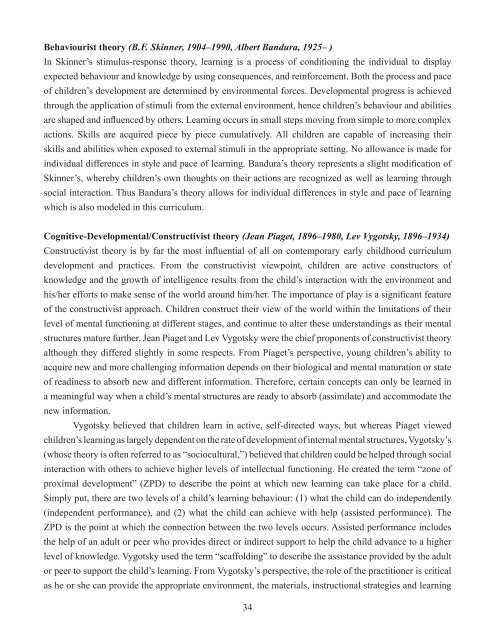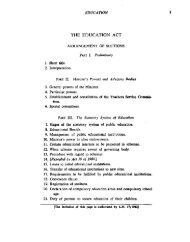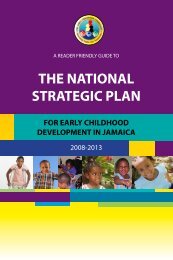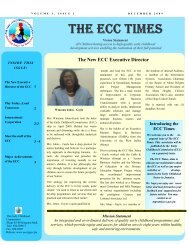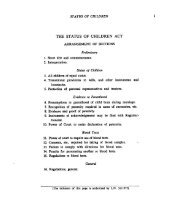The Jamaica Early Childhood Curriculum for Children Birth to Five
The Jamaica Early Childhood Curriculum for Children Birth to Five
The Jamaica Early Childhood Curriculum for Children Birth to Five
Create successful ePaper yourself
Turn your PDF publications into a flip-book with our unique Google optimized e-Paper software.
Behaviourist theory (B.F. Skinner, 1904–1990, Albert Bandura, 1925– )<br />
In Skinner’s stimulus-response theory, learning is a process of conditioning the individual <strong>to</strong> display<br />
expected behaviour and knowledge by using consequences, and rein<strong>for</strong>cement. Both the process and pace<br />
of children’s development are determined by environmental <strong>for</strong>ces. Developmental progress is achieved<br />
through the application of stimuli from the external environment, hence children’s behaviour and abilities<br />
are shaped and influenced by others. Learning occurs in small steps moving from simple <strong>to</strong> more complex<br />
actions. Skills are acquired piece by piece cumulatively. All children are capable of increasing their<br />
skills and abilities when exposed <strong>to</strong> external stimuli in the appropriate setting. No allowance is made <strong>for</strong><br />
individual differences in style and pace of learning. Bandura’s theory represents a slight modification of<br />
Skinner’s, whereby children’s own thoughts on their actions are recognized as well as learning through<br />
social interaction. Thus Bandura’s theory allows <strong>for</strong> individual differences in style and pace of learning<br />
which is also modeled in this curriculum.<br />
Cognitive-Developmental/Constructivist theory (Jean Piaget, 1896–1980, Lev Vygotsky, 1896–1934)<br />
Constructivist theory is by far the most influential of all on contemporary early childhood curriculum<br />
development and practices. From the constructivist viewpoint, children are active construc<strong>to</strong>rs of<br />
knowledge and the growth of intelligence results from the child’s interaction with the environment and<br />
his/her ef<strong>for</strong>ts <strong>to</strong> make sense of the world around him/her. <strong>The</strong> importance of play is a significant feature<br />
of the constructivist approach. <strong>Children</strong> construct their view of the world within the limitations of their<br />
level of mental functioning at different stages, and continue <strong>to</strong> alter these understandings as their mental<br />
structures mature further. Jean Piaget and Lev Vygotsky were the chief proponents of constructivist theory<br />
although they differed slightly in some respects. From Piaget’s perspective, young children’s ability <strong>to</strong><br />
acquire new and more challenging in<strong>for</strong>mation depends on their biological and mental maturation or state<br />
of readiness <strong>to</strong> absorb new and different in<strong>for</strong>mation. <strong>The</strong>re<strong>for</strong>e, certain concepts can only be learned in<br />
a meaningful way when a child’s mental structures are ready <strong>to</strong> absorb (assimilate) and accommodate the<br />
new in<strong>for</strong>mation.<br />
Vygotsky believed that children learn in active, self-directed ways, but whereas Piaget viewed<br />
children’s learning as largely dependent on the rate of development of internal mental structures, Vygotsky’s<br />
(whose theory is often referred <strong>to</strong> as “sociocultural,”) believed that children could be helped through social<br />
interaction with others <strong>to</strong> achieve higher levels of intellectual functioning. He created the term “zone of<br />
proximal development” (ZPD) <strong>to</strong> describe the point at which new learning can take place <strong>for</strong> a child.<br />
Simply put, there are two levels of a child’s learning behaviour: (1) what the child can do independently<br />
(independent per<strong>for</strong>mance), and (2) what the child can achieve with help (assisted per<strong>for</strong>mance). <strong>The</strong><br />
ZPD is the point at which the connection between the two levels occurs. Assisted per<strong>for</strong>mance includes<br />
the help of an adult or peer who provides direct or indirect support <strong>to</strong> help the child advance <strong>to</strong> a higher<br />
level of knowledge. Vygotsky used the term “scaffolding” <strong>to</strong> describe the assistance provided by the adult<br />
or peer <strong>to</strong> support the child’s learning. From Vygotsky’s perspective, the role of the practitioner is critical<br />
as he or she can provide the appropriate environment, the materials, instructional strategies and learning<br />
34


